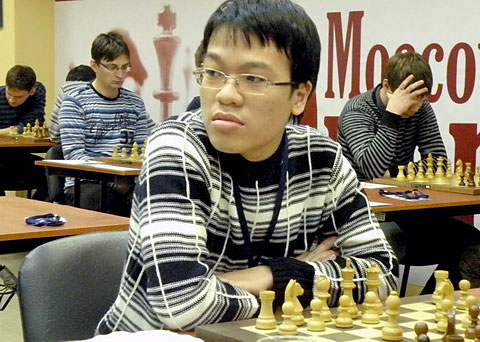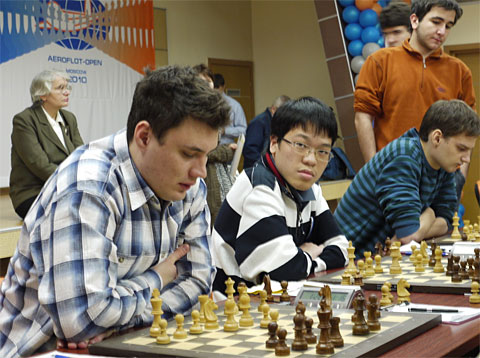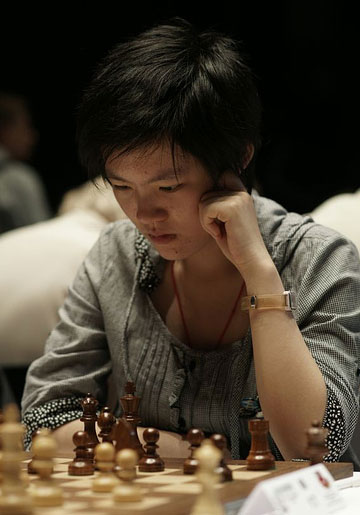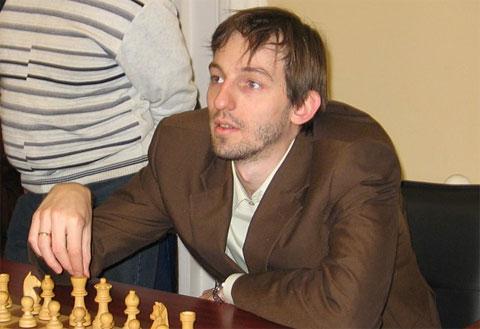| Latest | Greatest | Lobby | Journals | Search | Options | Help | Login |
|
|
|
This topic is archived. |
| Home » Discuss » Topic Forums » Sports |
|
| Jack Rabbit
|
Sun Feb-21-10 02:15 PM Original message |
| The JR Chess Report (February 21): Le wins Aeroflot; Topa leads Linares |
|
Vietnamese GM Le wins Aeroflot Open
 Eighteen-year-old Vietnamese grandmaster Le Quang Liem won the ninth annual Aeroflot Open Wednesday when he defeated another teenage grandmaster, Ian Nepomniachtchi of Russia, in the ninth and final round to finsh the event with 7 points. Grandmaster Anton Korobov of Russia was second with 6� points. Tied for third with 6 points each were Le's compatriot, Nguyen Ngoc Truongson, Alexander Motylev and Boris Grachev of Russian and China's Zhou Jianchao. Grandmaster Le had a very productive February in Moscow, where he also finished an equal first in the Moscow Open that ended just prior to the start of this year's Aeroflot. Le came to Moscow with an Elo rating of 2647 and leaves after unofficially breaking into the top 50 with a rating of 2689. As the winner of the Aeroflot Open, Le will be seeded to the elite Dortmund Sparkassen this summer. Topalov leads Linares, overtakes Magnus in world rankings  Former FIDE world champion Veselin Topalov of Bulgaria leads the 27th Torneo Internacional de la Ciudad de Linares with 5� points after eight rounds in capital of the state of Ja�n in the Andalus�a region of Spain. Reigning Russian national champion and defending tournament champion Alexander Grischuk is in second place with 4� points after defeating GM Vugar Gashimov of Azerbaijan moments ago. Grand Prix champion Levon Aronian of Armenia, who was lucky to escape with a draw agaisnt Topalov today, is in third place with 4 points. Topalov's performance thus far has put him two points ahead of Norwegian GM Magnus Carlsen in the unoffcial world rankings with a score of 2815. This is Topa's last scheduled tournament before playing in a match for the world championship against the current title holder, Vishy Anand of India, in the Bulgarian capital of Sofia starting April 23. Anand finished his pre-match schedule at the end of last month with a strong finish in Wijk aan Zee. Tomorrow is a rest day for players. The ninth round will be played Tuesday. The double round robin (ten rounds) tournament will finish Wednesday. Young Ukrainian Zherebukh takes Capelle la Grande Sixteen-year-old Ukrainian grandmaster Yaroslav Zherebukh won the 26th annual International Open in Cappelle la Grande, a town near the French coast of the North Sea a short distance southwest of Dunkerque. Zherebukh scored 7� points out of nine rounds and was the clear leader going into the final day, Friday. He drew his last game against another teenager, India's Paramarjan Negi, who was one of nine competitors to finish tied for second with 7 points each. The defending champion, Yuri Vovk of Ukraine, an old man of 22, had an up-and-down-and-up-again torunament. He began by winning his first four games, then lost three in a row before winning his last two. This year's edition of the Cappelle la Grande Open drew 653 participants. Calendar This Week: Reykjavik Open 24 February-3 March. Bundesliga 0910, Rounds 10-11, M�lheim, Heidelburg, Solingen, Trier. 27-28 February. Coming Attractions: European Individual Championships, Rijeka (Croatia) 5-19 March. Melody Amber Rapid/Blindfold Tournament, Nice. 12-25 March. Aronian, Carlsen, Dom�nguez, Gelfand, Gashimov, Ivanchuk, Karjakin, Kramnik, Morozevich, Ponomariov, Smeets and Svidler. Bundesliga 0910, Rounds 12-13, Emsdetten, Katernberg, Munich, K�nig Tegel (Berlin). 21-22 March. Philadelphia Open 31 March-4 April. This replaces the Foxwoods Open after the Foxwoods Resort announced expected room rate hikes. Russian Team Championships, Dagomys 1-12 April. Bundesliga 0910, Rounds 14-15 (season finale), Erfurt, Eppingen, Bremen, Baden Baden. 10-11 April. Women's Grand Prix, Nalchik 23 April-6 May. Anand-Topalov Match for the World Title, Sofia 23 April-10 May. Grand Prix, Astrakhan (Russia) 9-25 May. US Championship, St. Louis 13-25 May. Chicago Open 27-31 May. Women's Grand Prix, Jermuk 23 June-6 July. World Open, Valley Forge, Pennsylvania 29 June-5 July. Women's Grand Prix, Ulan Bator (Mongolia) 29 July-12 August. World Junior Championships, Chotowa Czarna (Poland) 2-17 August. Chess Olympiad, Khanty Mansiysk 19 September-4 October. European Club Cup, Plovdiv 16-24 October. Women's Grand Prix, Vina del Mar (Chile) 27 October-9 November. World Youth Championships, Halidiki (Greece) 19-31 October. FIDE Women's Knock Out (Women's World Championship), Turkey 2-25 December. |
| Printer Friendly | Permalink | | Top |
| Jack Rabbit
|
Sun Feb-21-10 02:17 PM Response to Original message |
| 1. This Week's Games |
|
Your humble hare acknowledges the assistance of Fritz 6.0 on analysis. Diagrams on the Jack Rabbit Chess Report are made with Chess M�rida, a true type font that can be downloaded free here. !""""""""# $tMvWlVmT% $OoOoOoOo% $ + + + +% $+ + + + % $ + + + +% $+ + + + % $pPpPpPpP% $RnBqKbNr% /(((((((() WHITE White to move (This position is a theoretical draw) I would like to thank my impressive and loyal staff: Buccaneer, Spitfire, Swashbuckler, Pancho and Robin Hood. |
| Printer Friendly | Permalink | | Top |
| Jack Rabbit
|
Sun Feb-21-10 02:18 PM Response to Reply #1 |
| 2. Aeroflot Open, Moscow |
| Printer Friendly | Permalink | | Top |
| Jack Rabbit
|
Sun Feb-21-10 02:23 PM Response to Reply #2 |
| 5. Le Quang Liem - Nepomniachtchi, Round 9 |
 Le Quang Liem Le Quang Liem - Ian Nepomniachtchi 9th Aeroflot Open, Round 9 Moscow, 17 February 2010 Symmetrical English Game: Four Knights' Opening 1.Nf3 Nf6 2.c4 c5 3.Nc3 Nc6 4.d4 cxd4 5.Nxd4 Qb6
6.Nb3 e6 7.e4
7...Bb4 8.Bd3 Ne5
9.0-0 Qd6 10.Bf4 Bxc3!?
11.bxc3 Qxd3 12.Bxe5 Qxc4!?
13.Re1!?
13...b6 14.Qf3 Bb7 15.Nd4!?
15...0-0-0!?
16.a4 Qc5
17.Bg3 e5
18.a5!?
18...Rhe8!?
19.axb6 axb6 !""""""""# $ +lTt+ +% $+v+o+oOo% $ O + M +% $+ W O + % $ + Np+ +% $+ P +qV % $ + + PpP% $R + R K % /(((((((() WHITE: Le Quang Liem Position after 19...ab6:p 20.Nf5!
20...g6
21.Ng7 Nxe4 22.Nxe8 Rxe8 23.Qxf7
23...Rf8 24.Qa2 Qc6 25.f3 Qc5+!?
26.Bf2 Nxf2 27.Qxf2 Qxf2+
28.Kxf2 e4 29.Re3 Kc7
30.Kg3!
30...exf3 31.gxf3 Bd5 32.Ra4 Be6 33.Rh4 h5!?
!""""""""# $ + + T +% $+ Lo+ + % $ O +v+o+% $+ + + +o% $ + + + R% $+ P RoK % $ + + + P% $+ + + + % /(((((((() WHITE: Le Quang Liem Position after 33...h7h5 34.Rf4!?
34...Ra8 35.h4 Ra5
36.Rf6 Bf5 37.Kf4 Rc5!?
38.Kg5!
38...Bc2+ 39.Kh6 Rc4 40.f4 b5
41.Re5 Rc6
42.Rf7
42...Kb6?
!""""""""# $ + + + +% $+ +o+r+ % $ Lt+ +oK% $+o+ R +o% $ + + P P% $+ P + + % $ +v+ + +% $+ + + + % /(((((((() WHITE: Le Quang Liem Position after 42...Kc7b6 43.Rxd7! Rxc3 44.Rd8?!
44...Ka5 45.Rb8 Rb3 46.Rc8
46...Bb1?
47.Rb8
47...Ka4
48.Rb6 Rb4
49.Ra6+ Kb3 !""""""""# $ + + + +% $+ + + + % $r+ + +oK% $+o+ R +o% $ T + P P% $+l+ + + % $ + + + +% $+v+ + + % /(((((((() WHITE: Le Quang Liem Position after 49...Ka4b3 50.Rxg6!!
50...Bxg6 51.Kxg6 Rxf4 52.Rxb5+ Kc4 53.Rxh5
53...Rg4+ 54.Kf5 Rg8 55.Rg5 Rh8
!""""""""# $ + + + T% $+ + + + % $ + + + +% $+ + +kR % $ +l+ + P% $+ + + + % $ + + + +% $+ + + + % /(((((((() WHITE: Le Quang Liem Position after 55...Rg8h8 56.h5!
56...Kd5
57.Kg6+ Ke6 58.Kg7 Re8 59.h6 Re7+ 60.Kg6 1-0
|
| Printer Friendly | Permalink | | Top |
| Jack Rabbit
|
Sun Feb-21-10 02:24 PM Response to Reply #2 |
| 6. Naiditsch - Korobov, Round 8 |
 Anton Korobov Arkadij Naiditsch - Anton Korobov 9th Aeroflot Open, Round 8 Moscow, 16 February 2010 Open Sicilian Game: Najdorf-Scheveningen Defense (Rauzer Opening) 1.e4 c5 2.Nf3 d6 3.d4 cxd4 4.Nxd4 Nf6 5.Nc3 a6 6.Bg5 Nbd7
7.Qe2 e6 8.f4 Qc7 9.0-0-0 Be7
10.g3
10...h6 11.Bh4
11...b5 12.Bg2 b4!?
13.e5
13...dxe5
14.Bxa8!?
14...bxc3!
15.fxe5 Nxe5 16.Rhe1?
!""""""""# $b+v+l+ R% $+ W VoO % $o+ +oM O% $+ + M + % $ + N + B% $+ O + P % $pPp+q+ P% $+ KrR + % /(((((((() WHITE: Arkadij Naiditsch Position after 16.Rh1e1 16...Qb8!
17.bxc3
17...Ba3+!
18.Kd2 Nfd7 19.Bc6 Nxc6 20.Nxc6 Qd6+ 21.Nd4
21...g5!
22.Qh5 Nf6 23.Qf3
23...Nd5 24.Nf5 Qc5 25.c4 Qb4+
26.Ke2
26...Qxc4+ 27.Kf2 Bc5+ 28.Kg2 Kf8
29.Kh3 Bb7 30.Re4 Qxc2 31.Rxe6
!""""""""# $ + + L T% $+v+ +o+ % $o+ +r+ O% $+ Vm+nO % $ + + + B% $+ + +qPk% $o+w+ + P% $+ +r+ + % /(((((((() WHITE: Arkadij Naiditsch Position after 31.Re4e6:p 31...Nf4+!!
32.gxf4
32...Qxf5+ 0-1
|
| Printer Friendly | Permalink | | Top |
| Jack Rabbit
|
Sun Feb-21-10 02:26 PM Response to Reply #2 |
| 7. Grachev - Sjugirov, Round 5 |
 Boris Grachev Boris Grachev - Sanan Sjugirov 9th Aeroflot Open, Round 5 Moscow, 13 February 2010 Semi-Slav Queen's Gambit: Stoltz Opening 1.d4 d5 2.c4 c6 3.e3 Nf6 4.Nc3 e6 5.Nf3 Nbd7 6.Qc2 Bd6 7.Bd3 dxc4 8.Bxc4
8...a6
9.a4 0-0 10.0-0 c5 11.Rd1
11...cxd4
12.exd4 Qc7 13.Qe2 e5!?
14.h3
14...exd4 15.Nxd4 Be5!?
!""""""""# $t+v+ Tl+% $+oWm+oOo% $o+ + M +% $+ + V + % $p+bN + +% $+ N + +p% $ p +qPp+% $R Br+ K % /(((((((() WHITE: Boris Grachev Position after 15...Bd6e5 16.Be3!
16...Bf4 17.Nd5 Nxd5 18.Bxd5 Bxe3 19.Qxe3
19...Nf6 20.Bf3
20...Bd7 21.Rdc1 Qd6 22.Nb3 Rae8!?
!""""""""# $ + +tTl+% $+o+v+oOo% $o+ W M +% $+ + + + % $p+ + + +% $+m+ Qb+p% $ P + Pp+% $R R + K % /(((((((() WHITE: Boris Grachev Position after 22...Ra8e8 23.Qd4!
23...Qxd4!
24.Nxd4 b6!?
25.b4 h6 26.a5 bxa5 27.bxa5 Rc8
28.Nc6!?
28...Bxc6!
29.Bxc6 Rc7 30.Bf3 Rfc8
31.Rcb1
31...Re8 32.Rb6 Ra7!?
33.Bc6!
33...Re6 34.f4 g5 35.f5 Rd6?
!""""""""# $ + + +l+% $T + +o+ % $oRbT M O% $P + +pO % $ + + + +% $+ + + +p% $ + + +p+% $R + + K % /(((((((() WHITE: Boris Grachev Position after 35...Re6d6 36.Bb5!
36...Ne4 37.Be2 Rd2
38.Rxa6
38...Rad7 39.Bf3 Nc5 40.Rxh6
40...Nb3
41.Ra3 Nd4 42.a6 Nxf3+ 43.Rxf3 Ra2
44.Rg3 Kg7 45.Rb6 f6 46.h4 Ra7
47.hxg5 R2xa6 48.gxf6+ Kf8
49.Rxa6 Rxa6 !""""""""# $ + + L +% $+ + + + % $t+ + P +% $+ + +p+ % $ + + + +% $+ + + R % $ + + +p+% $+ + + K % /(((((((() WHITE: Boris Grachev Position after 49...Ra7a6:R 50.Rg6!
50...Ra5
51.g4 Ra2 52.Rg7 Rb2 53.g5 1-0
|
| Printer Friendly | Permalink | | Top |
| Jack Rabbit
|
Sun Feb-21-10 02:28 PM Response to Reply #2 |
| 8. Pashikian - Nepomniachtchi, Round 7 |
|
Edited on Sun Feb-21-10 02:29 PM by Jack Rabbit
 Ian Nepomniachtchi Aman Pashikian - Ian Nepomniachtchi 9th Aeroflot Open, Round 7 Moscow, 15 February 2010 West India Game: Indian Queen's Gambit (Exchange Opening) (Gr�nfeld Defense) 1.d4 Nf6 2.c4 g6 3.Nc3 d5 4.cxd5
4...Nxd5 5.e4 Nxc3 6.bxc3 Bg7 7.Be3
7...c5 8.Rc1 Qa5 9.Qd2 0-0 10.Nf3 Nd7
11.Bd3!?
11...e5 12.d5 b5
13.0-0
13...c4 14.Bc2 Qa3!?
15.Rb1!
15...Rb8
16.Qc1 Qxc1 17.Rfxc1
17...a5 18.a4!?
!""""""""# $ Tv+ Tk+% $+ +m+oVo% $ + + +o+% $Oo+pO + % $p+o+p+ +% $+ P Bn+ % $ +b+ PpP% $+rR + K % /(((((((() WHITE: Aman Pashikian Position after 18.a2a4 18...b4!
19.cxb4!?
19...axb4 20.Bd1 c3
21.Be2 f5
22.g3
22...Rf6
23.Bb5 Bf8 24.Bc6 Bd6 25.a5!?
25...Rf8
26.exf5?!
!""""""""# $ Tv+ Rl+% $+ +m+ +o% $ +bV +o+% $P +pOp+ % $ O + + +% $+ O VnP % $ + + P P% $+rR + K % /(((((((() WHITE: Aman Pashikian Position after 26.ef5:p 26...Nc5!
27.Nxe5?
27...Bxf5!
28.Nc4
28...Bxb1 29.Nxd6
29...Bd3 30.Bd4 Nb3 31.Rxc3 bxc3 32.Bxc3 0-1
|
| Printer Friendly | Permalink | | Top |
| Jack Rabbit
|
Sun Feb-21-10 02:31 PM Response to Reply #2 |
| 9. Hou Yifan - Salem, Round 6 |
|
The young lady will be 16 at the end of the month.
 Hou Yifan Hou Yifan - Saleh Salem 9th Aeroflot Open, Round 6 Moscow, 14 February 2010 Sardinian Game: King's Bishop Opening 1.e4 e5 2.Bc4 Nf6 3.d3
3...c6
4.Qe2!?
4...d5 5.exd5
5...cxd5 6.Bb5+
6...Nc6
7.Qxe5+ Be7!?
8.Nf3
8...0-0 9.Bxc6 bxc6 10.0-0 Bd6
11.Qe2 Re8 12.Qd1 Rb8 13.b3 h6 14.Bb2 Nh5
15.Re1 Bg4
16.Nbd2 Nf4
17.Re3
17...Qd7
18.Qf1 f6
19.Rxe8+ Qxe8 20.h3 Bd7
21.Kh1 c5
!""""""""# $ T +w+l+% $O +v+ O % $ + V O O% $+ Oo+ + % $ + + M +% $+p+p+ +p% $pBpN Pp+% $R + +q+k% /(((((((() WHITE: Hou Yifan Position after 21...c6c5 22.Ng1!?
22...Qh5 23.Re1 a5 24.Ndf3
24...d4 25.Bc1 Nd5!?
26.a4
26...Nb4 27.Re2 g5?!
28.Nd2 Qg6
29.Nc4 Bc7 30.Ba3 Nd5?
!""""""""# $ T + +l+% $+ Vv+ + % $ + + OwO% $O Om+ O % $p+nO + +% $Bp+p+ +p% $ +p+rPp+% $+ + +qNk% /(((((((() WHITE: Hou Yifan Position after 30...Nb4d5 31.Bxc5!
31...Nf4 32.Re7
32...Qf5 33.Bxd4 Kf8
34.Ne3
34...Kxe7 35.Nxf5+ Bxf5 36.Qe1+
36...Kf7 37.Qc3 Rc8 38.Nf3 Bd6
!""""""""# $ +t+ + +% $+ + +l+ % $ + V O O% $O + +vO % $p+ B M +% $+pQp+n+p% $ +p+ Pp+% $+ + + +k% /(((((((() WHITE: Hou Yifan Position after 38...Bc7d6 39.Qxa5!
39...Be6 40.Qa7+ Kg6 41.Qa6 1-0
|
| Printer Friendly | Permalink | | Top |
| Jack Rabbit
|
Sun Feb-21-10 02:20 PM Response to Reply #1 |
| 3. 27th Torneo de la Ciudad de Linares |
 Linares native Andr�s Segovia (click on the photo for more) |
| Printer Friendly | Permalink | | Top |
| Jack Rabbit
|
Sun Feb-21-10 02:32 PM Response to Reply #3 |
| 10. Topalov - Gashimov, Round 2 |
 Veselin Topalov Veselin Topalov - Vugar Gashimov 27th Torneo de la Ciudad de Linares, Round 2 Linares, 15 February 2010 Slav Queen's Gambit: Tikhi Opening 1.d4 d5 2.c4 c6 3.Nf3 Nf6 4.e3 a6
5.Qc2 g6
6.Bd3 Bg7 7.0-0
7...0-0 8.Nbd2 Nbd7 9.cxd5!?
9...cxd5
10.b3 Nb8 11.Ba3 Nc6 12.Rac1 Be6!?
13.Qb2!
13...Re8
14.h3
14...Rc8 15.Rc2 Bf5 16.Bxf5!
16...gxf5 17.Ne1
17...Ne4 18.Nd3 e5 19.Nxe4
19...dxe4
20.Nxe5 Nxe5 21.dxe5 Rxc2 22.Qxc2 Qa5
23.Bd6 Bxe5 24.b4!?
24...Qd8 25.Bxe5 Rxe5 26.Rc1
26...Rd5 27.a4
27...b5 28.axb5 Rxb5!?
!""""""""# $ + W +l+% $+ + +o+o% $o+ + + +% $+t+ +o+ % $ P +o+ +% $+ + P +p% $ +q+ Pp+% $+ R + K % /(((((((() WHITE: Veselin Topalov Position after 28...Rd5b5:p 29.Qa4!
29...Qd6 30.Qa1 Qe5
31.Qxa6 Rxb4 32.Qh6 Rb8 33.g3
33...Qe6
34.Qf4
34...Rc8 35.Rd1!
35...Rc6?!
36.Rd8+ Kg7 37.Kg2
37...h6?
!""""""""# $ + R + +% $+ + +oL % $ +t+w+ O% $+ + +o+ % $ + +oQ +% $+ + P Pp% $ + + Pk+% $+ + + + % /(((((((() WHITE: Veselin Topalov Position after 37...h7h6 38.Qb8!
38...Qf6
39.Rd5?!
39...Re6?
40.h4 h5
!""""""""# $ Q + + +% $+ + +o+ % $ + +tW +% $+ +r+o+p% $ + +o+ P% $+ + P P % $ + + Pk+% $+ + + + % /(((((((() WHITE: Veselin Topalov Position after 40...h6h5 41.Rd8!
41...Kh7
42.Rg8 f4
43.gxf4
43...Qxh4 44.Rh8+ Kg6 45.Qg8+ Kf6 46.Qd8+ Re7 47.Rh6+ Kf5 48.Qd5+ 1-0
|
| Printer Friendly | Permalink | | Top |
| Jack Rabbit
|
Sun Feb-21-10 02:33 PM Response to Reply #3 |
| 11. Grischuk - Gelfand, Round 2 |
 Alexander Grischuk Alexander Grischuk - Boris Gelfand 27th Torneo de la Ciudad de Linares, Round 2 Linares, 15 February 2010 East India Game: Nimzo-Indian Defense (Rubinstein Opening/Main Line) 1.d4 Nf6 2.c4 e6 3.Nc3 Bb4 4.e3
4...0-0
5.Bd3
5...d5 6.Nf3 c5 7.0-0 dxc4 8.Bxc4 Nbd7
9.Qe2
9...a6
10.a4
10...cxd4
11.exd4 Nb6 12.Bd3
12...Nbd5 13.Nxd5
13...Nxd5
14.Qe4
14...g6!?
15.Bh6 Re8 16.Ne5!
16...Bd7 17.Qf3 Qe7 18.Be4 Bc6 19.Bxd5
19...Bxd5 20.Qf4 f5
21.h4 Rac8 22.Rac1 Bd6
23.Rfe1!?
23...Qf6
24.Rc3
24...Rxc3
25.bxc3 Rc8 26.Qg3 Be4?
!""""""""# $ +t+ +l+% $+o+ + +o% $o+ VoWoB% $+ + No+ % $p+ Pv+ P% $+ P + Q % $ + + P +% $+ + R K % /(((((((() WHITE: Alexander Grischuk Position after 26...Bd5e4 27.h5!
27...Bxe5
28.dxe5 Qf7 29.Re3!
29...Kh8
30.Qh4!
30...gxh5
31.Rg3 Bd5 32.a5 f4
!""""""""# $ +r+ + +% $+o+ +w+o% $o+ +o+ B% $P +vP +o% $ + + O Q% $+ P + R % $ + + Pp+% $+ + + K % /(((((((() WHITE: Alexander Grischuk Position after 32...f5f4 33.Rg7!
33...Qf5 34.Qe7 Qe4 35.Qf6 1-0
|
| Printer Friendly | Permalink | | Top |
| Jack Rabbit
|
Sun Feb-21-10 02:22 PM Response to Reply #1 |
| 4. 26th International Open, Cappelle la Grande |
| Printer Friendly | Permalink | | Top |
| Jack Rabbit
|
Sun Feb-21-10 02:35 PM Response to Reply #4 |
| 12. Zherebukh - Kovalyov, Round 6 |
|
This game should be viewed with Grischuk-Gelfand, Linares, above, as an example of a well-executed Kingside attack.
Yaroslav Zherebukh, the clear winner of the 26th Cappelle la Grande Open, is a sixteen-year-old GM from Ukraine.  Yaroslav Zherebukh Yaroslav Zherebukh - Anton Kovalyov 26th International Open, Round 6 Cappelle la Grande, 17 February 2010 Open Sicilian Game: Taimanov Defense 1.e4 c5 2.Nf3 e6 3.d4 cxd4 4.Nxd4 Nc6
5.Nc3 a6 6.Bf4
6...d6 7.Bg3 Nf6
8.Be2 Be7 9.Nxc6
9...bxc6 10.e5 Nd5 11.exd6 Bxd6 12.Ne4 Bxg3
13.hxg3 f5!?
14.Bh5+
14...Kf8!?
!""""""""# $t+bW L T% $+ + + Oo% $o+o+o+ +% $+ +m+o+b% $ + +n+ +% $+ + + P % $pPp+ Pp+% $R +qK +r% /(((((((() WHITE: Yaroslav Zherebukh Position after 14...Ke8f8 15.Qf3!?
15...Qa5+
16.c3 Rb8 17.Nd6
17...Qc5
18.Nxc8!
18...Rxc8 19.Qe2 Nc7
20.0-0-0 Ke7
21.Qd2 Kf6 22.b4 Qe7 23.g4!
23...g6
!""""""""# $ +t+ + T% $+ M W +o% $o+o+oLo+% $+ + +o+b% $ P + +p+% $+ P + + % $p+ Q Pp+% $+ Kr+ +r% /(((((((() WHITE: Yaroslav Zherebukh Position after 23...g7g6 24.gxf5!!
24...gxh5?
25.Qh6+!
25...Kf7 26.f6 Qf8 27.Rd7+
27...Ke8 28.Re7+ Kd8 29.Qf4 Qxe7
30.fxe7+ Kxe7 31.Qg5+ Kf7 32.Qxh5+ Kf6 33.Qh6+
33...Kf7 34.Rh3 Rhf8
35.Rf3+ Kg8 36.Rg3+ Kf7 37.Rg7+ Ke8 38.Qh5+ 1-0
|
| Printer Friendly | Permalink | | Top |
| Jack Rabbit
|
Sun Feb-21-10 02:36 PM Response to Reply #4 |
| 13. Abergel - Negi, Round 8 |
 Parimarjan Negi Thal Abergel - Parimarjan Negi 26th International Open, Round 8 Cappelle la Grande, 19 February 2010 Open Sicilian Game: Najdorf-Dragon Defense 1.e4 c5 2.Nf3 d6 3.d4 cxd4 4.Nxd4 Nf6 5.Nc3 a6 6.Qf3
6...g6 7.h3
7...Bg7 8.Be3 Bd7 9.g4 Nc6 10.0-0-0 0-0
11.Qg2!?
11...Rc8
12.Be2 Nxd4 13.Bxd4 e5!?
14.Be3!
14...Rxc3 15.bxc3 Qa5 16.g5 Nh5
17.Bxh5 gxh5 18.Qf1?
!""""""""# $ + + Tl+% $+o+v+oVo% $o+ O + +% $W + O Po% $ + +p+ +% $+ P B +p% $p+p+ P +% $+ Kr+q+r% /(((((((() WHITE: Parimarjan Negi Position after 18.Qg2f1 18...Rc8!
19.c4 Be6!
20.Qd3
20...Bxc4
21.Qxd6 Qxa2 22.Qd7 Qa3+?!
23.Kd2 Qa5+?
24.Kc1!
24...Be6
25.Qxb7 Bf8 26.Rhe1??
!""""""""# $ +t+ Vl+% $+q+ +o+o% $o+ +v+ +% $W + O Po% $ + +p+ +% $+ + B +p% $ +p+ P +% $+ KrR + % /(((((((() WHITE: Parimarjan Negi Position after 26.Rh1e1 26...Bb4! 0-1
|
| Printer Friendly | Permalink | | Top |
| Jack Rabbit
|
Tue Feb-23-10 03:18 PM Response to Original message |
| 14. Update from Linares (Tuesday): Topa and Gris go to last round tied for 1st |
|
Edited on Tue Feb-23-10 03:19 PM by Jack Rabbit
 Reigning Russian national chmpion Alexander Grischuk defeated former FIDE world champion Veselin Topalov moments ago in 56 moves to catch Topalov in first place with only one round left to play in the 27th Torneo Internacional de la Ciudad de Linares in Andaluc�a. Both players have won 3, lost 1 and drawn 5 for 5� points out of a possible 9. Levon Aronian, the only player with any chance of catching the pair, is in third place with 4� ponts. Topalov defeated Grischuk in round 5 on Thursday to take a point and a half lead at that time. Tomorrow, the tournament concludes with Topalov playing White against Boris Gelfand and Grischuk facing Paco Vallejo from the Black side of the board. |
| Printer Friendly | Permalink | | Top |
| Jack Rabbit
|
Wed Feb-24-10 04:51 PM Response to Original message |
| 15. Update (Wednesday): Topalov wins Linares; Reykjavik Open begins |
|
Edited on Wed Feb-24-10 04:51 PM by Jack Rabbit
Topalov victorious in Linares
 Former FIDE world champion Veselin Topalov took advantage of a blunder in the endgame to defeat World Cup winner Boris Gelfand and claim first prize clear today in the 27th Torneo Internacional de Ajedrez held in Linares, the capital of Ja�n in the Andaluc�a region of Spain. Topalov began the day tied for first place with defending tournament champion Alexander Grischuk, who is also the reigning Russian national champion. Grischuk got into trouble in his game against Spanish national champion Paco Vallejo and had to settle for a draw. When Gelfand resinged to Topalov, Grischuk found himself a half-point short of first place. Reykjavik Open begins  The annual international open tournament in the Icelandic capital of Reykjavik began today with 104 players participating. There were few surprises in the first round, with top seeds Vladimir Baklan (Ukraine), Alexey Dreev (Russia), Ivan Sokolov (Bosnia), Yuriy Kuzubov (Ukraine) and Yury Shulman (United States) all winning. |
| Printer Friendly | Permalink | | Top |
| DU
AdBot (1000+ posts) |
Sat May 04th 2024, 06:42 PM Response to Original message |
| Advertisements [?] |
| Top |
| Home » Discuss » Topic Forums » Sports |
|
Powered by DCForum+ Version 1.1 Copyright 1997-2002 DCScripts.com
Software has been extensively modified by the DU administrators
Important Notices: By participating on this discussion board, visitors agree to abide by the rules outlined on our Rules page. Messages posted on the Democratic Underground Discussion Forums are the opinions of the individuals who post them, and do not necessarily represent the opinions of Democratic Underground, LLC.
Home | Discussion Forums | Journals | Store | Donate
About DU | Contact Us | Privacy Policy
Got a message for Democratic Underground? Click here to send us a message.
© 2001 - 2011 Democratic Underground, LLC